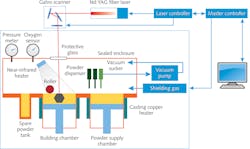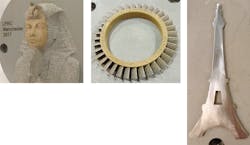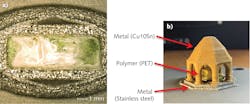LIN LI
Laser powder-bed fusion (LPBF), also known as selective laser melting (SLM), is one of the most widely used additive manufacturing technologies for the production of metallic components of complex internal structures with applications ranging from medical implants to aero-engine components.
The process is based on spreading a thin layer (<100 µm) of metallic powder (typically 20–50 µm in size) onto a build platform with a blade or a roller, followed by selective laser fusion of a single layer of powder based on the digital design pattern for each layer. Then, the build platform is lowered by one layer and the next layer of powder is laid, and selective laser fusion is carried out until the whole component is completed. The unmelted powders are used to partially support the structures built above. To avoid component distortion and for the manufacture of overhang structures, additional support structures using the same material are often needed and created in the digital design and in the build process. The support structures are subsequently removed mechanically.
Multiple components can be built within the same platform. One drawback of the existing LPBF systems is that only a single type of material can be used to build each component and it had not been possible to make multiple material components in a single process due to the inherent limitations in the conventional powder-bed spreading system. To enable the freedom of component design and allow the tailoring of localized material properties at different locations of a component, multiple material additive manufacturing is desirable.
In the last few years, the research team in the Laser Processing Research Centre at the University of Manchester (Manchester, England) designed and demonstrated a new LPBF system configuration that allowed the additive manufacturing of multiple and functionally graded components with multiple materials not only across different layers, but also within the same layer.1-7 This would open up new additive manufacturing applications that may not be possible before.
Multiple-material powder-bed fusion system
As shown in FIGURE 1, the multiple-material LPBF system introduces additional dry powder delivery nozzles and ultrasonic powder delivery systems that can deliver different types of powders at desired location on each layer and in different layers. This is combined with the conventional powder bed spread system. In addition, a microvacuum selective-material removal system is integrated to remove unwanted materials from each layer. The rest of the system is similar to a standard LPBF machine. As the existing software tool for LPBF is only suitable for the printing of single materials, a software tool for multiple-material additive manufacturing needs to be different and tailored for the new purpose.Experimental demonstration and potential applications
Several multiple material components have been printed at the University of Manchester using this technology (FIGURE 2). The materials used include 316L stainless steel and Cu10Sn copper alloy and their mixtures. Up to seven different materials can be printed within a single component based on the current experimental system. Multiple metallic components, metal-glass, and metal-polymer components can be printed, as shown in FIGURE 3. A great advantage of manufacturing for multiple materials 3D printing is that the interface structures between different materials can be made complex providing interlocks1 and gradual change of materials from one type to another (functional grading)3 is possible.
Potential applications of this technology may include easy-to-remove support materials in LPBF,4 embedding security features in additive manufactured components,5 manufacture of jewelry,6 and medical implants.7Summary
This article has introduced a multiple material and functionally graded material 3D additive manufacturing technology and a system based on laser powder-bed fusion. Multiple metallic and metallic/nonmetallic material combinations have been fabricated in a single integrated additive manufacturing platform. In addition, if a small component is printed, there would be no need to have a large amount of powders, as seen in conventional LPBF systems. These advances would open up new applications and scientific research.
The University of Manchester has filed a number of patent applications (GB1706645.7, GB1800743.5, GB1810721.9, PCT/GB18/051093, PCT/GB2019/051854, US16/608,735, Europe 18722159.3, and China 2018800432853) for this technology worldwide and welcomes interested licensing opportunities for commercial uses.
ACKNOWLEDGEMENTS
The author gratefully acknowledges the research team, particularly Chao Wei, Xiaoji Zhang, and Yuanhui Chueh, for their research to develop the technology described in this article. The author also acknowledges the support from The University of Manchester for two PhD studentships for the development of this technology.
REFERENCES
1. C. Wei, L. Li, X. J. Zhang, and Y. H. Chueh, CIRP Ann.-Manuf. Techn., 67, 1, 245–248 (2018).
2. C. Wei et al., Addit. Manuf., 29, 100818 (Oct. 2019).
3. C. Wei, Z. Sun, Q. Chen, Z. Liu, and L. Li, J. Manuf. Sci. Eng., 141, 8, 081014 (Aug. 2019).
4. C. Wei et al., J. Manuf. Sci. Eng., 141, 7, 0710002 (Jul. 2019).
5. C. Wei, Z. Sun, Y. Huang and L. Li, Addit. Manuf., 24, 1–12 (2018).
6. X. Zhang, C. Wei, Y.-H. Chueh, and L. Li, J. Manuf. Sci. Eng., 141, 1, 011003 (Jan. 2019).
7. Y. H. Chueh, C. Wei, X. Zhang, and L. Li, Addit. Manuf., 31, 100928 (2020).
Professor LIN LI ([email protected]) is with the Laser Processing Research Centre, Faculty of Science and Engineering, Department of Mechanical, Aerospace and Civil Engineering, The University of Manchester, Manchester, England.


